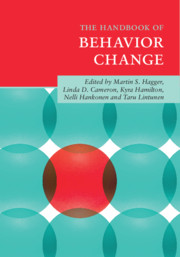Book contents
- The Handbook of Behavior Change
- The Handbook of Behavior Change
- Copyright page
- Dedication
- Contents
- Figures
- Tables
- Sidebars
- Contributors
- 1 Changing Behavior: A Theory- and Evidence-Based Approach
- Part I Theory and Behavior Change
- Part II Methods and Processes of Behavior Change: Intervention Development, Application, and Translation
- Part III Behavior Change Interventions: Practical Guides to Behavior Change
- 31 Attitudes and Persuasive Communication Interventions
- 32 Self-Efficacy Interventions
- 33 Imagery, Visualization, and Mental Simulation Interventions
- 34 Affect-Based Interventions
- 35 Autonomy-Supportive Interventions
- 36 Incentive-Based Interventions
- 37 Monitoring Interventions
- 38 Goal Setting Interventions
- 39 Planning and Implementation Intention Interventions
- 40 Self-Control Interventions
- 41 Habit Interventions
- 42 Economic and Behavioral Economic Approaches to Behavior Change
- 43 Dyadic Behavior Change Interventions
- 44 Social Identity Interventions
- 45 Motivational Interviewing Interventions
- 46 The Science of Behavior Change: The Road Ahead
- Index
- References
36 - Incentive-Based Interventions
from Part III - Behavior Change Interventions: Practical Guides to Behavior Change
Published online by Cambridge University Press: 04 July 2020
- The Handbook of Behavior Change
- The Handbook of Behavior Change
- Copyright page
- Dedication
- Contents
- Figures
- Tables
- Sidebars
- Contributors
- 1 Changing Behavior: A Theory- and Evidence-Based Approach
- Part I Theory and Behavior Change
- Part II Methods and Processes of Behavior Change: Intervention Development, Application, and Translation
- Part III Behavior Change Interventions: Practical Guides to Behavior Change
- 31 Attitudes and Persuasive Communication Interventions
- 32 Self-Efficacy Interventions
- 33 Imagery, Visualization, and Mental Simulation Interventions
- 34 Affect-Based Interventions
- 35 Autonomy-Supportive Interventions
- 36 Incentive-Based Interventions
- 37 Monitoring Interventions
- 38 Goal Setting Interventions
- 39 Planning and Implementation Intention Interventions
- 40 Self-Control Interventions
- 41 Habit Interventions
- 42 Economic and Behavioral Economic Approaches to Behavior Change
- 43 Dyadic Behavior Change Interventions
- 44 Social Identity Interventions
- 45 Motivational Interviewing Interventions
- 46 The Science of Behavior Change: The Road Ahead
- Index
- References
Summary
This chapter provides a framework for how incentives affect behavior change. Economic theory is built on the premise that incentives matter, but empirical evidence shows the effect of incentives on behavior is more complicated than predicted by the basic law of demand. Our framework highlights four potential “channels” through which incentives can affect behavior change: First, incentives can help create “desirable” or “adaptive” habits by building up the stock of behavior. Increasing recent experience makes current behavior less costly and more enjoyable. Second, incentives can help “kill” undesirable or maladaptive habits by reducing the stock of behavior. Decreasing recent experience makes current behavior costlier and less enjoyable. Third, incentives can help counter present bias. Using frequent and regular incentives helps change behavior. Fourth, incentives can help remove barriers to change. Using incentives to reduce switching costs makes uptake of the desired behavior or activity cheaper or even free. These four channels and the supporting empirical evidence for them have implications for how incentive-based interventions work and provide guidance on how best to design them for optimal efficacy.
Keywords
- Type
- Chapter
- Information
- The Handbook of Behavior Change , pp. 523 - 536Publisher: Cambridge University PressPrint publication year: 2020



